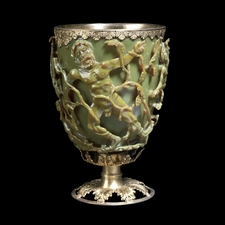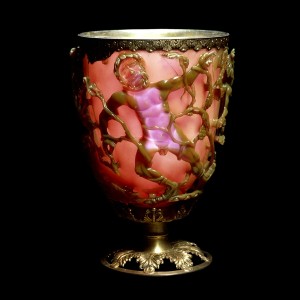The Lycurgus Cup has long fascinated me. It’s an ancient piece of art that is nanotechnology-enhanced so that depending on how the light hits it, the cup glows either green or red.

The Lycurgus Cup 1958,1202.1 in reflected light. Scene showing Lycurgus being enmeshed by Ambrosia, now transformed into a vine-shoot. Department of Prehistory and Europe, The British Museum. Height: 16.5 cm (with modern metal mounts), diameter: 13.2 cm. © The Trustees of the British Museum
I must admit to a preference for the red simply because I can better see the designs.

The Lycurgus Cup 1958,1202.1 in transmitted light. Scene showing Lycurgus being enmeshed by Ambrosia, now transformed into a vine-shoot. Department of Prehistory and Europe, The British Museum. Height: 16.5 cm (with modern metal mounts), diameter: 13.2 cm. © The Trustees of the British Museum
The *History of the Ancient World website (as Nov. 21, 2013 the link has been changed to the Université de Strasbourg,, Matière Condensée et Nanophysique website) recently featured a 2007 article about the Lycurgus Cup by Ian Freestone, Nigel Meeks, Margaret Sax and Catherine Higgitt for the Gold Bulletin, Vol. 40:4 (2007),
The Lycurgus Cup represents one of the outstanding achievements of the ancient glass industry. This late Roman cut glass vessel is extraordinary in several respects, firstly in the method of fabrication and the exceptional workmanship involved and secondly in terms of the unusual optical effects displayed by the glass.
The Lycurgus Cup is one of a class of Roman vessels known as cage cups or diatreta, where the decoration is in openwork which stands proud from the body of the vessel, to which it is linked by shanks or bridges Typically these openwork “cages” comprise a lattice of linked circles, but a small number have figurative designs, although none of these is as elaborate or as well preserved as the Lycurgus Cup. Cage cups are generally dated to the fourth century A.D. and have been found across the Roman Empire, but the number recovered is small, and probably only in the region of 50-100 examples are known. They are among the most technically sophisticated glass objects produced before the modern era.
The article itself can be viewed or downloaded from here. The cup as noted can be two different colours,
The glass of the cup is dichroic; in direct light it resembles jade with an opaque greenish-yellow tone, but when light shines through the glass (transmitted light) it turns to a translucent ruby colour
The presence of colloidal metals (gold-silver) give the glass at least some of its unusual optical properties according to the authors. Although reading between the lines, it seems that even today we can’t duplicate what those 4th century Roman glassmakers achieved.
The Lycurgus Cup demonstrates a short-lived technology developed in the fourth century A.D. by Roman glass-workers. They discovered that glass could be coloured red and unusual colour change effects generated by the addition of a precious metal bearing material when the glass was molten. We now understand that these effects are due to the development of nanoparticles in the glass. However, the inability to control the colourant process meant that relatively few glasses of this type were produced, and even fewer survive. The Cup is the outstanding example of this technology in every respect – its outstanding cut work and red-green dichroism render it a unique record.
There you have it, ancient Roman nanotechnology.
*Nov. 21, 2013 I changed the link to the article as the History of the Ancient World website is no longer hosting this article.
ETA July 21, 2014: April Holloway has written a piece about the Lycurgus Cup which has been published in two places,
Epoch Times: http://www.theepochtimes.com/n3/807475-1600-year-old-goblet-shows-that-the-romans-used-nanotechnology/ (this features an image of the green and red ‘cups’ side-by-side with a ‘nano’ background)
Ancient Origins: http://www.ancient-origins.net/news-history-archaeology/1600-year-old-goblet-shows-romans-used-nanotechnology-00793#!bjfuCU (image of the green and red ‘cups’ side-by-side featured)